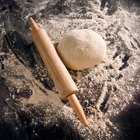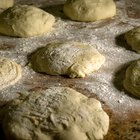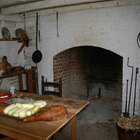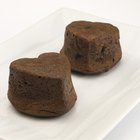
The smell of bread baking is enough to make your mouth water. The last thing you want is a dense, hard loaf of bread that resembles a brick when it comes out of the oven. Avoid that disappointment by ensuring your bread dough rises completely during preparation. Create the right conditions in your own kitchen to make sure the yeast in the dough undergoes the chemical reaction needed to guarantee a light, fully risen loaf of bread.
Step 1
Check the expiration date on the package of yeast you plan to use to assure it is still active. Expired or inactive yeast typically will not react adequately to cause the dough to rise. Prepare the yeast by allowing it to dissolve completely in water or milk that is between 105 and 115 degrees Fahrenheit. Assemble the bread ingredients per your recipe.
Step 2
Knead the dough exactly as called for in the recipe. This makes the dough smoother and more elastic and helps create the desired texture.
Step 3
Lightly grease a large bowl. Shape the dough into a ball with your hands and put it into the bowl. Turn the ball over so the greased side faces up and cover it loosely with a damp kitchen towel or plastic wrap. If using the latter, lightly grease the side that faces the dough to avoid it sticking to the dough as it rises.
Step 4
Place the covered bowl with the dough in a warm, draft-free location in your kitchen or elsewhere in the house. In most kitchens, the top of the refrigerator is a consistently warm spot. You can also place a bowl of hot water on the bottom shelf of your oven and place the bowl of dough on the shelf immediately above it and shut the oven door. On top of a warm clothes dryer in the laundry room is another option. Any of these will work as long as the temperature is 85 degrees F or higher.
Related Articles

How to Preserve Dough That Has Risen

Quick Method for Thawing Frozen Bread ...
Can You Refrigerate Homemade Yeast ...
Quick and Easy French Bread Recipe

How to Freeze Brioche

How to Make Dough in a KitchenAid Mixer
How to Make Homemade Bread
How to Make Homemade Cinnamon Rolls

What to Do With Pizza Dough When You're ...

How to Bake Bread in Stoneware
Easy Cinnamon Roll Recipe

How to Make a Pasta Bread Bowl

How to Make Homemade Pizza Without Yeast

How to Make Light Airy Italian Bread ...

How to Use a Bread Machine to Make Dough

Can You Use Vegetable Oil Instead of ...

How to Make Bread From Colonial Times

What Is a Souffle Dish?
How to Make Bread That Does Not Crumble ...

How to Make Egyptian Bread the Egyptian ...
References
Tips
- You can make your own warm spot for your dough to rise by turning on the oven to the lowest possible temperature. Allow it to heat up, then put the covered bowl of bread dough inside the heated oven. Close the door tightly and turn off the oven. The dough should rise well in the warm enclosed space. If the oven cools off before the dough rises completely -- typically it doubles its starting size -- briefly turn on the oven and allow it to heat up again then turn it off.
- Store any unused yeast in the refrigerator.
Writer Bio
As a national security analyst for the U.S. government, Molly Thompson wrote extensively for classified USG publications. Thompson established and runs a strategic analysis company, is a professional genealogist and participates in numerous community organizations.Thompson holds degrees from Wellesley and Georgetown in psychology, political science and international relations.
Photo Credits
Jupiterimages/Photos.com/Getty Images